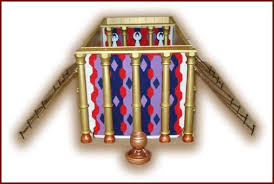The Outer Veil of the Sanctuary
26:36-37 and 36:37-38
The Sanctuary portion of the Tabernacle was like three cubes, fifteen feet high, by fifteen feet wide, by forty-five feet long. The first section was called the Holy Place and would be made up of two of those three cubes, fifteen feet high, fifteen feet wide and thirty feet long. The priests entered the Sanctuary through the Holy Place, and then there was a veil between the Holy Place and the third cube, or the Most Holy Place, which was fifteen feet high, fifteen feet wide and fifteen feet long. The Most Holy Place was, therefore, a perfect cube, reminding us of the new Jerusalem (Revelation 21:2 and 16).
The significance of the outer veil was again a point of separation. The veil separated the high priest from all other priests, and the outer veil separated the Tribe of Levi from all other tribes. Unless you were a member of the tribe of Levi, you could not go beyond that point. Israelites could be out in the courtyard, but no Israelite, unless he was of the tribe of Levi, could go through the entrance to the Holy Place.

The entrance to the Holy Place was made of an outer veil, a curtain of blue, purple, and scarlet yarn and finely twisted linen. However, it was not as luxurious as that of the inner veil. There were no cherubim embroidered on this veil. An embroiderer, someone other than a master craftsman like Bezalel, made the outer veil. Therefore, it was certainly magnificent, but not to the same degree as the inner veil. The courtyard, the gate, the inner veil, and the covering of the Sanctuary were all composed of the same finely twisted white linen that pointed to the purity of Christ. The way it was assembled, it was impossible for anyone to carry out any of the pieces of furniture without first dismantling the Holy Place. Gold hooks held this curtain to five posts of acacia wood overlaid with gold. However, its five bases were made of bronze, not silver, because it would be a part of the exterior that had bronze throughout.
Bronze always speaks of judgment and points to what Christ endured on the cross for our sakes. As a result, we are reminded once more that He is the gate by reason of His suffering and death. May the Holy Spirit continually keep before us the tremendous price that was paid to enable us to enter into the Most Holy Place with Him and call Him: Abba, Father (Romans 8:15).557



Hi
According to Daniel the Rock will come to judge over the ten kings. Is if fair to say that bronze and the rock symbolises the righteousness of our father?
I also gave permission for the comments I made to be used by this web site. I did send a mail, but did not receive a comment whether it was received or not..
Hi Armand,
Regarding bronze, in my commentary on Exodus, and writing about the courtyard (see Ey – The Size of the Courtyard in the Tabernacle), I wrote, “Because of the metals used in the construction of the Tabernacle are listed in descending order of value, the further away you went from the Most Holy Place, the less valuable the metal used. Thus, the courtyard was mostly constructed of bronze, which spoke of judgment.” Especially the bronze altar.
As far as the Rock is concerned. It is used throughout the bible as symbolizing Messiah, and therefore, yes, the righteousness of the Father.
Blessings,
David